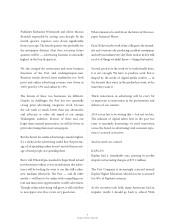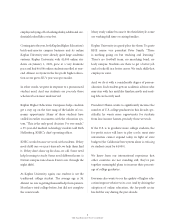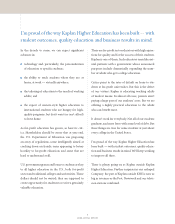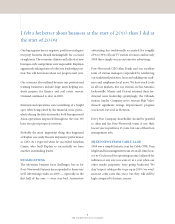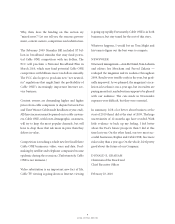Washington Post 2009 Annual Report Download - page 17
Download and view the complete annual report
Please find page 17 of the 2009 Washington Post annual report below. You can navigate through the pages in the report by either clicking on the pages listed below, or by using the keyword search tool below to find specific information within the annual report.
nonrepayable grants. Subsidized loans and grants are only available to students who can demonstrate financial need.
During 2009, about 71% of the approximately $1,283 million of Title IV funds received by Kaplan Higher Education
came from student loans, and approximately 29% of such funds came from grants.
Title IV Eligibility. To maintain Title IV eligibility, a school must comply with extensive statutory and regulatory
requirements relating to its financial aid management, educational programs, financial strength, administrative capability,
facilities, recruiting practices and various other matters. Among other things, the school must be licensed or otherwise
authorized to offer its educational programs by the appropriate governmental body in the state or states in which it is
physically located, be accredited by an accrediting agency recognized by the U.S. Department of Education (the
“Department of Education”) and be certified to participate in the Title IV programs by the Department of Education.
Schools are required periodically to apply for renewal of their authorization, accreditation or certification with the
applicable state governmental bodies, accrediting agencies and the Department of Education. In accordance with
Department of Education regulations, some schools in Kaplan Higher Education are combined into groups of two or more
schools for the purpose of determining compliance with certain Title IV requirements, and each such group is assigned its
own identification number, known as an OPEID number. As a result, the schools in Kaplan’s Higher Education division
have a total of 33 OPEID numbers.
No assurance can be given that the Kaplan schools currently participating in Title IV programs will maintain their Title IV
eligibility, accreditation and state authorization in the future or that the Department of Education might not successfully
assert that one or more of such schools have previously failed to comply with Title IV requirements.
Student Default Rates. A school may lose its eligibility to participate in Title IV programs if student defaults on the
repayment of Title IV loans exceed specified rates, referred to as “cohort default rates.” The Department of Education
calculates a cohort default rate for each of Kaplan Higher Education’s OPEID numbers. The schools in an OPEID number
whose cohort default rate exceeds 40% for any single year may lose their eligibility to participate in the Federal Family
Education Loan (“FFEL”) and Direct Loan programs and Federal Pell Grant programs for at least two fiscal years, except in
the event of a successful adjustment or appeal. The schools in an OPEID number whose cohort default rate equals or
exceeds 25% for three consecutive years may lose their Title IV eligibility to participate in FFEL, Direct Loan and Federal
Pell Grant programs for at least two fiscal years, except in the event of a successful adjustment or appeal. The schools in
an OPEID number whose cohort default rate equals or exceeds 25% in any one of the three most recent fiscal years for
which rates have been issued by the Department of Education may be placed on provisional certification by the
Department of Education.
The enactment in August 2008 of the Higher Education Opportunity Act (which reauthorized the Federal Higher
Education Act) changed the methodology that will be used to calculate cohort default rates for future years. Under the
revised law, the period of time for which student defaults are tracked and included in the cohort default rate calculation is
extended by a year, which is expected to increase the cohort default rates for most institutions. That change became
effective with the calculation of institutions’ cohort default rates for the federal fiscal year ending September 30, 2009;
those rates are expected to be calculated and issued by the Department of Education in 2012. The Department of
Education will not impose sanctions based on rates calculated under this new methodology until three consecutive years
of rates have been calculated, which is expected to occur in 2014. Until that time, the Department of Education will
continue to calculate rates under the old method and impose sanctions based on those rates. The revised law also
increases the threshold for ending an institution’s participation in certain Title IV programs from 25% to 30% for three
consecutive years, effective for three-year cohort default rates issued beginning in fiscal year 2012.
The cohort default rate for Kaplan University (which comprises 52% of Kaplan Higher Education’s revenue) and for all of
Kaplan Higher Education for the federal fiscal year periods 2007, 2006 and 2005 were as follows:
Cohort Year Ended
September 30
2007 2006 2005
Kaplan University .............................. 13.3% 9.2% 5.9%
Total Kaplan Higher Education ..................... 17.8% 14.7% 9.7%
For the 2007 cohort year, four reporting units had a cohort default rate of 25% or more. For the 2008 cohort year,
which has been issued in draft form by the Department of Education, only one reporting unit had a cohort default rate
greater than 25%, and none had two or more consecutive years above 25%. These 2008 draft rates are not final and
are subject to revision. Based on the 2008 draft cohort default rates, we expect Kaplan University’s 2008 fiscal year
cohort default rate to be between 15% and 17%, and the overall Kaplan Higher Education rate to be between 16% and
18%. Student loan default rates tend to be higher in certificate and associate’s degree programs as compared to
bachelor’s and graduate degree programs. A majority of Kaplan Higher Education students are enrolled in certificate and
associate’s degree programs.
2009 FORM 10-K 3


